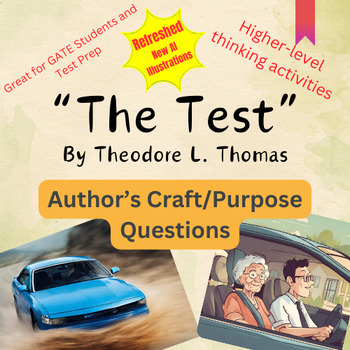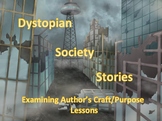Test by Theodore L. Thomas Author's Purpose Questions and Activites
Karen Rohach - Author's Purpose Expert
85 Followers
Grade Levels
7th - 10th
Subjects
Resource Type
Standards
CCSSRL.9-10.4
CCSSRL.9-10.10
CCSSL.9-10.3
CCSSL.9-10.5
CCSSCCRA.R.4
Formats Included
- PDF
Pages
14 pages
Karen Rohach - Author's Purpose Expert
85 Followers
Also included in
- This is a compilation of stories which deal with dystopian societies. Each story has questions asking students to examine the strategies the author uses in order to determine the author's message. These are higher-level thinking questions which challenge students.Price $8.75Original Price $12.50Save $3.75
Description
This product contains questions which explore the literary elements used in the story and ask students to determine for what purpose they were used. The higher-level thinking questions help students to determine the message/theme of the story. It also includes a vocabulary identification chart which uses context clues and a short contructed response question. Answers are provided for all activities.
Total Pages
14 pages
Answer Key
Included
Teaching Duration
N/A
Report this resource to TPT
Reported resources will be reviewed by our team. Report this resource to let us know if this resource violates TPT’s content guidelines.
Standards
to see state-specific standards (only available in the US).
CCSSRL.9-10.4
Determine the meaning of words and phrases as they are used in the text, including figurative and connotative meanings; analyze the cumulative impact of specific word choices on meaning and tone (e.g., how the language evokes a sense of time and place; how it sets a formal or informal tone).
CCSSRL.9-10.10
By the end of grade 9, read and comprehend literature, including stories, dramas, and poems, in the grades 9-10 text complexity band proficiently, with scaffolding as needed at the high end of the range.By the end of grade 10, read and comprehend literature, including stories, dramas, and poems, at the high end of the grades 9-10 text complexity band independently and proficiently.
CCSSL.9-10.3
Apply knowledge of language to understand how language functions in different contexts, to make effective choices for meaning or style, and to comprehend more fully when reading or listening.
CCSSL.9-10.5
Demonstrate understanding of figurative language, word relationships, and nuances in word meanings.
CCSSCCRA.R.4
Interpret words and phrases as they are used in a text, including determining technical, connotative, and figurative meanings, and analyze how specific word choices shape meaning or tone.



